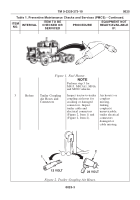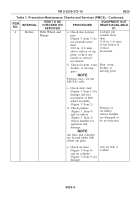TM-9-2320-273-10 - Page 302 of 452
PURPOSE OF PMCS TABLE
The purpose of the PMCS table is to provide a systematic method of inspection and
servicing of equipment. In this way, small defects can be detected early and corrected
before they become major problems causing equipment failure. The PMCS table is
arranged with the individual PMCS procedures listed in sequence under assigned
intervals. The most logical time (before, during, and after operation) to perform each
procedure determines the interval to which it is assigned. Make a habit of performing
the checks in the same order each time; anything wrong will be identified quickly.
Refer to WP 0025 for Operator PMCS.
The following is a list and description of the column headings in the PMCS table.
Item Number
- This column shows the sequence in which the checks and services
are to be performed and is used to identify equipment area on the Equipment
Inspection and Maintenance Worksheet, DA Form 2404 or DA Form 5988-E.
Interval
- This column indicates when each check is to be performed.
Item to be Checked or Serviced
- This column identifies the item and location to
be checked by part, component, or assembly name.
Procedure
- This column explains what type of service, specific damage, or defect
is to be checked.
Equipment Not Ready/Available If:
- This column lists conditions that make the
equipment unavailable for use as a result of damage, missing parts, or improper
functioning that presents a safety hazard. Do not accept or operate equipment with
a condition noted in this column.
CORROSION PREVENTION AND CONTROL (CPC) (PMCS)
Corrosion Prevention and Control (CPC) is a continuing concern. It is important that
any corrosion problems with this equipment be reported so improvements can be made
and future problems eliminated.
Corrosion is typically associated with rusting of metals or galvanic corrosion, which
produces a white powder. This category of corrosion also includes deterioration of
other materials such as rubber and plastic. Unusual cracking, softening, swelling, or
breaking of materials may be the result of corrosion. If a corrosion problem is
identified, it can be reported using SF 368, Product Quality Deficiency Report. Use of
key words such as “corrosion,” “rust,” “deterioration,” or “cracking” ensure the
information is identified as a CPC problem. Submit the form to the address specified in
DA PAM 750-8.
TM 9-2320-273-10
0024
0024-2
Back to Top




















